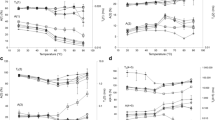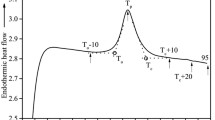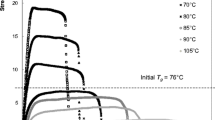Abstract
Raw maize starch, initially stored at ambient temperature and relative humidity, was examined by means of Broadband Dielectric Spectroscopy in the temperature range from 30 to 130 °C and in the frequency range from 0.1 Hz to 1 MHz. The α-relaxation processes of amylose and amylopectin were, for the first time, separately recorded and analyzed by employing the electric modulus formalism, while the gelatinization mechanism is discussed and modeled. Molecular dynamics analysis, conducted via the Vogel–Fulcher–Tammann equation, and the Debye and Cole–Cole dielectric function models were employed to further understand the gelatinization process and the dielectric behavior of amylose and amylopectin respectively. In addition, the transformation of V-amylose to free amylose was also observed and discussed.





Similar content being viewed by others
References
Dong Y, Matson JB, Edgar KJ (2017) Olefin cross-metathesis in polymer and polysaccharide chemistry: a review. Biomacromol 18:1661–1676. https://doi.org/10.1021/acs.biomac.7b00364
Ruellan A, Guinault A, Sollogoub C et al (2015) Industrial vegetable oil by-products increase the ductility of polylactide. Express Polym Lett 9:1087–1103. https://doi.org/10.3144/expresspolymlett.2015.98
Zhang Y, Rempel C, Liu Q (2014) Thermoplastic starch processing and characteristics: a review. Crit Rev Food Sci Nutr 54:1353–1370. https://doi.org/10.1080/10408398.2011.636156
Chung YL, Ansari S, Estevez L et al (2010) Preparation and properties of biodegradable starch-clay nanocomposites. Carbohydr Polym 79:391–396. https://doi.org/10.1016/j.carbpol.2009.08.021
Tavares LB, Boas CV, Schleder GR et al (2016) Bio-based polyurethane prepared from Kraft lignin and modified castor oil. Express Polym Lett 10:927–940. https://doi.org/10.3144/expresspolymlett.2016.86
Jane J, Chen YY, Lee LF et al (1999) Effects of amylopectin branch chain length and amylose content on the gelatinization and pasting properties of starch. Cereal Chem 76:629–637. https://doi.org/10.1094/CCHEM.1999.76.5.629
Nafchi AM, Moradpour M, Saeidi M, Alias AK (2013) Thermoplastic starches: properties, challenges, and prospects. Starch/Staerke 65:61–72. https://doi.org/10.1002/star.201200201
Tábi T, Kovács JG (2007) Examination of injection moulded thermoplastic maize starch. Express Polym Lett 1:804–809. https://doi.org/10.3144/expresspolymlett.2007.111
Zaikov GE (2005) Chemistry of polysaccharides. Nova Science Publishers, New York
Belitz HD, Grosch W, Schieberle P et al (2009) Food chemistry. Springer, Berlin
Obiro WC, Sinha Ray S, Emmambux MN (2012) V-amylose structural characteristics, methods of preparation, significance, and potential applications. Food Rev Int 28:412–438. https://doi.org/10.1080/87559129.2012.660718
Xie F, Pollet E, Halley PJ, Avérous L (2013) Starch-based nano-biocomposites. Prog Polym Sci 38:1590–1628. https://doi.org/10.1016/j.progpolymsci.2013.05.002
Karger-Kocsis J, Kmetty Á, Lendvai L et al (2015) Water-assisted production of thermoplastic nanocomposites: a review. Materials (Basel) 8:72–95. https://doi.org/10.3390/ma8010072
Hongsprabhas P, Israkarn K (2008) New insights on the characteristics of starch network. Food Res Int 41:998–1006. https://doi.org/10.1016/j.foodres.2008.08.008
Tester RF, Morrison WR (1990) Swelling and gelatinization of cereal starches. I. Effects of amylopectin, amylose, and lipids. Cereal Chem 67:551–557
Drakopoulos SX, Karger-Kocsis J, Kmetty Á et al (2017) Thermoplastic starch modified with microfibrillated cellulose and natural rubber latex: a broadband dielectric spectroscopy study. Carbohydr Polym 157:. https://doi.org/10.1016/j.carbpol.2016.10.036
Lendvai L, Karger-Kocsis J, Kmetty A, Drakopoulos SX (2016) Production and characterization of microfibrillated cellulose-reinforced thermoplastic starch composites. J Appl Polym Sci. https://doi.org/10.1002/app.42397
Hietala M, Mathew AP, Oksman K (2013) Bionanocomposites of thermoplastic starch and cellulose nanofibers manufactured using twin-screw extrusion. Eur Polym J 49:950–956. https://doi.org/10.1016/j.eurpolymj.2012.10.016
Moon RJ, Martini A, Nairn J et al (2011) Cellulose nanomaterials review: structure, properties and nanocomposites. Chem Soc Rev 40, 3941–3994.
Angellier H, Molina-Boisseau S, Dole P, Dufresne A (2006) Thermoplastic starch-Waxy maize starch nanocrystals nanocomposites. Biomacromol 7:531–539. https://doi.org/10.1021/bm050797s
Wu D, Samanta A, Srivastava RK, Hakkarainen M (2017) Starch-derived nanographene oxide paves the way for electrospinnable and bioactive starch scaffolds for bone tissue engineering. Biomacromol 18:1582–1591. https://doi.org/10.1021/acs.biomac.7b00195
Radhakrishnan J, Subramanian A, Krishnan UM, Sethuraman S (2017) Injectable and 3D bioprinted polysaccharide hydrogels: from cartilage to osteochondral tissue engineering. Biomacromol 18:1–26. https://doi.org/10.1021/acs.biomac.6b01619
Mele E (2016) Electrospinning of natural polymers for advanced wound care: towards responsive and adaptive dressings. J Mater Chem B 4:4801–4812. https://doi.org/10.1039/C6TB00804F
Kanapitsas A, Tsonos C, Psarras GC, Kripotou S (2016) Barium ferrite/epoxy resin nanocomposite system: fabrication, dielectric, magnetic and hydration studies. Express Polym Lett 10:227–236. https://doi.org/10.3144/expresspolymlett.2016.21
Tsonos C, Pandis C, Soin N et al (2015) Multifunctional nanocomposites of poly(vinylidene fluoride) reinforced by carbon nanotubes and magnetite nanoparticles. Express Polym Lett 9:1104–1118. https://doi.org/10.3144/expresspolymlett.2015.99
Tsangaris GM, Psarras GC, Kouloumbi N (1998) Electric modulus and interfacial polarization in composite polymeric systems. J Mater Sci 33:2027–2037. https://doi.org/10.1023/A:1004398514901
Tsangaris GM, Psarras GC (1999) Dielectric response of a polymeric three-component composite. J Mater Sci 34:2151–2157. https://doi.org/10.1023/A:1004528330217
Psarras GC, Sofos GA, Vradis A et al (2014) HNBR and its MWCNT reinforced nanocomposites: crystalline morphology and electrical response. Eur Polym J 54:190–199. https://doi.org/10.1016/j.eurpolymj.2014.03.002
Psarras GC, Siengchin S, Karahaliou PK et al (2011) Dielectric relaxation phenomena and dynamics in polyoxymethylene/polyurethane/alumina hybrid nanocomposites. Polym Int 60:1715–1721. https://doi.org/10.1002/pi.3136
Kremer F, Schönhals A (2003) Broadband dielectric spectroscopy. Springer, Berlin
Vryonis O, Anastassopoulos DL, Vradis AA, Psarras GC (2016) Dielectric response and molecular dynamics in epoxy-BaSrTiO3 nanocomposites: effect of nanofiller loading. Polymer 95:82–90. https://doi.org/10.1016/j.polymer.2016.04.050
Kalmykov YP, Coffey WT, Crothers DSF, Titov SV (2004) Microscopic models for dielectric relaxation in disordered systems. Phys Rev E 70:11. https://doi.org/10.1103/PhysRevE.70.041103
Psarras GC (2010) Conductivity and dielectric characterization of polymer nanocomposites. In: Tjong SC, Mai Y-W (eds) Physical properties and applications of polymer nanocomposites, 1st edn. Elsevier, Amsterdam, pp 31–69
Cole KS, Cole RH (1941) Dispersion and absorption in dielectrics I. Alternating current characteristics. J Chem Phys 9:341–351. https://doi.org/10.1063/1.1750906
Davidson DW, Cole RH (1950) Dielectric relaxation in glycerine. J Chem Phys 18:1417–1417. https://doi.org/10.1063/1.1747496
Havriliak S, Negami S (1967) A complex plane representation of dielectric and mechanical relaxation processes in some polymers. Polymer 8:161–210. https://doi.org/10.1016/0032-3861(67)90021-3
Miller LA, Gordon J, Davis EA (1991) Dielectric and thermal transition properties of chemically modified starches during heating. Cereal Chem 68:441–448
Venkatesh MS, Raghavan GSV (2004) An overview of microwave processing and dielectric properties of agri-food materials. Biosyst Eng 88:1–18. https://doi.org/10.1016/j.biosystemseng.2004.01.007
Einfeldt J, Meißner D, Kwasniewski A, Einfeldt L (2001) Dielectric spectroscopic analysis of wet and well dried starches in comparison with other polysaccharides. Polymer 42:7049–7062. https://doi.org/10.1016/S0032-3861(01)00152-5
Majumder TP, Meißner D, Schick C (2004) Dielectric processes of wet and well-dried wheat starch. Carbohydr Polym 56:361–366. https://doi.org/10.1016/j.carbpol.2004.03.005
Majumder TP, Meißner D, Schick C, Roy SK (2006) Phase transition phenomena and the corresponding relaxation process of wheat starch-water polymer matrix studied by dielectric spectroscopic method. Carbohydr Polym 65:129–133. https://doi.org/10.1016/j.carbpol.2005.12.034
Kalini A, Gatos KG, Karahaliou PK, Georga SN, Krontiras CA, Psarras GC (2010) Probing the dielectric response of polyurethane/alumina nanocomposites. J Polym Sci Part B: Polym Phys 48:2346–2354. https://doi.org/10.1002/polb.22120
Myllärinen P (2002) The crystallinity of amylose and amylopectin films. Carbohydr Polym 48:41–48. https://doi.org/10.1016/S0144-8617(01)00208-9
Raphaelides S, Karkalas J (1988) Thermal dissociation of amylose-fatty acid complexes. Carbohydr Res 172:65–82
Maistros GM, Bucknall CB, Bedford C, Oal MK (1994) Resin blends during curing. Polym Eng Sci 34:1517–1528
Funding
The work reported here was supported by the Hungarian Scientific Research Fund (OTKA) through the project K 109409.
Author information
Authors and Affiliations
Corresponding author
Rights and permissions
About this article
Cite this article
Drakopoulos, S.X., Karger-Kocsis, J. & Psarras, G.C. In Situ Thermodielectric Analysis of the Gelatinization Mechanism of Raw Maize Starch: An Experimental and Theoretical Approach. J Polym Environ 27, 333–342 (2019). https://doi.org/10.1007/s10924-018-1348-7
Published:
Issue Date:
DOI: https://doi.org/10.1007/s10924-018-1348-7




